Why this resume works
- Highlights industry-specific skills: Through roles like dialysis technician, the applicant’s healthcare skills shine in improving treatment efficiency and ensuring safety protocol compliance.
- Quantifies accomplishments: Measurable accomplishments like improving dialysis efficiency by 20% reflect a significant impact on patient care and operational success.
- Showcases career progression: Starting as a medical assistant and advancing to dialysis technician, the applicant showcases career progression with increasingly complex responsibilities over time.
More Dialysis Technician Resume Examples
See our dialysis technician resume examples to learn how to highlight your patient care skills, equipment management experience, and attention to detail. These medical resume samples will guide you in crafting a resume that stands out.
Entry-Level Dialysis Technician
Why this resume works
- Effective use of keywords: By weaving in role-specific keywords like dialysis machine operation and healthcare safety protocols, the applicant optimizes their resume for ATS.
- Shows digital literacy: The applicant’s ability to document medical data and operate advanced equipment reflects essential computer skills needed for modern workplaces.
- Puts skills at the forefront: Organizing key skills like patient care expertise and efficiency strategies at the top mirrors the skills-based resume format, ideal for emphasizing strengths early.
Mid-Level Dialysis Technician
Why this resume works
- Includes a mix of soft and hard skills: Combining technical prowess with interpersonal skills, the applicant’s background in healthcare technology and patient care shows a versatile skill set.
- Demonstrates language abilities: Language skills in Spanish, French, and German facilitate effective cross-cultural communication in diverse healthcare settings.
- Displays technical expertise: Expertise in calibrating biomedical equipment with 95% accuracy and certifications as a technician show the applicant’s specialized technical knowledge.
Experienced Dialysis Technician
Why this resume works
- Focuses on work history: Using a chronological resume format, the applicant organizes extensive healthcare experience into clear timelines, showcasing consistent growth and dedication to patient care over 15 years.
- Lists relevant certifications: Certifications like Certified Dialysis Technician and Advanced Patient Care Certification reflect specialized expertise and an ongoing commitment to professional development.
- Emphasizes leadership skills: By training new hires and developing an onboarding manual, the applicant highlights their leadership skills, emphasizing team empowerment and operational excellence.
Dialysis Technician Resume Template (Text Version)
Tao Liu
Minneapolis, MN 55405
(555)555-5555
Tao.Liu@example.com
Professional Summary
Skilled dialysis technician with 6 years in renal care. Expert in patient monitoring, enhancing treatment efficiency, and documentation. Dedicated to providing compassionate care and optimizing clinical operations.
Work History
Dialysis Technician
Evergreen Renal Care – Minneapolis, MN
January 2024 – August 2025
- Monitored 85 patients monthly
- Improved dialysis efficiency by 20%
- Ensured compliance with safety protocols
Patient Care Technician
Cascade Medical Center – Minneapolis, MN
May 2021 – December 2023
- Assisted in reducing hospital readmission rate by 15%
- Administered medication to 60 patients weekly
- Collaborated with team for patient care improvement
Medical Assistant
Pine Valley Health Group – Minneapolis, MN
August 2019 – April 2021
- Managed scheduling for 250+ appointments monthly
- Streamlined patient intake process by 30%
- Maintained medical records with 98% accuracy
Skills
- Patient Care
- Dialysis Equipment Operation
- Safety Protocols
- Medical Coding
- Empathy and Compassion
- Team Collaboration
- Clinical Documentation
- Time Management
Education
Master of Science Health Sciences
University of Washington Seattle, WA
June 2019
Bachelor of Science Biology
Washington State University Pullman, WA
June 2017
Certifications
- Certified Dialysis Technician – National Nephrology Association
- Basic Life Support (BLS) – American Heart Association
Languages
- Spanish – Beginner (A1)
- Chinese – Intermediate (B1)
- French – Beginner (A1)
Related Resume Guides
- Clinical Documentation Improvement Specialist
- Clinical Project Manager
- Clinical Research Assistant
- Clinical Trial Associate
- Coding Specialist
- Dermatologist
- Doctor
- Electrocardiograph Technician
- Emergency Department Technician
- Emergency Room Registration Clerk
- Equipment Technician
- Health Information Technician
- Hospital Administrator
- Hospital Volunteer
- Intake Coordinator
- Intensive Care Physician
- Medical Laboratory Technologist
- Medical Records Specialist
- Medical Representative
- Medical Research Assistant
- Midwife
- MRI Technologist
- Neurosurgeon
- Nuclear Medicine Technologist
- OB-GYN Medical Assistant
- Ophthalmologist
- Ophthalmology Assistant
- Optometrist
- Orthopedic Surgeon
- Pediatric Assistant
- Pediatrician
- Physician
- Physician Assistant
- Podiatrist
- Psychiatrist
- Radiologist
- Radiology Technician
- Resident Medical Officer
- Respiratory Therapist
- Speech Language Pathologist
- Surgeon
- Surgery Scheduler
- Ultrasound Technician
Advice for Writing Your Dialysis Technician Resume
Dive into our advice section on how to write a resume tailored for dialysis technician roles. Discover how to highlight your technical skills, patient care experience, and teamwork abilities in a way that stands out. Whether you’re new to the field or looking to refresh your approach, these tips will help you craft a resume that captures your dedication to improving patient health.
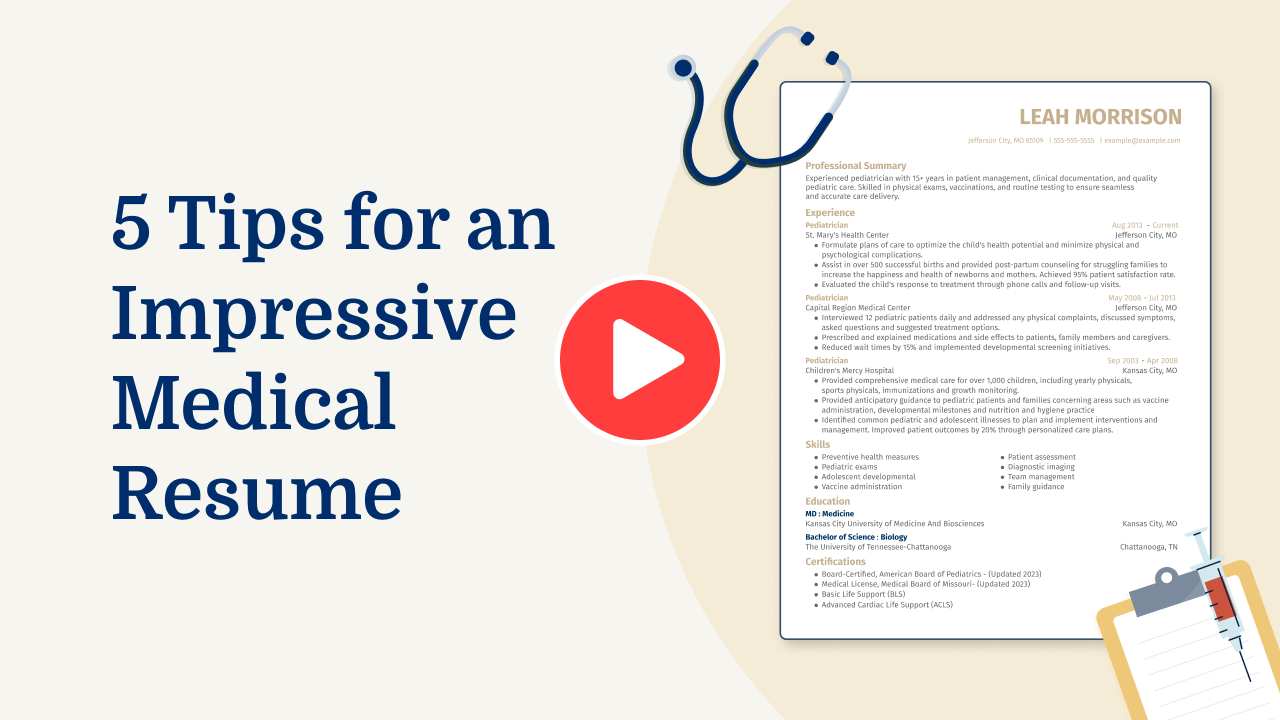
Write a strong professional summary
A professional summary is a brief introduction at the top of a resume, offering hiring managers a snapshot of who you are. It’s important to decide between writing a summary or an objective as they cater to different stages in your career.
The professional summary typically consists of three to four sentences that showcase your experience, skills, and achievements. It’s ideal for those with some experience under their belt, like seasoned dialysis technicians. Its purpose is to highlight your professional identity and the value you bring to the role.
Conversely, a resume objective outlines career goals and is better suited for entry-level applicants, career changers, or those with employment gaps. An easy way to distinguish them is by thinking of a summary as “what I’ve accomplished” and an objective as “what I aim to contribute.”
Next, we’ll provide examples of both summaries and objectives tailored to various industries and levels of experience. See our full library of resume examples for additional inspiration.
Dialysis technician resume summary examples
Entry-level
Recent graduate with an Associate of Applied Science degree in dialysis technology, equipped with foundational knowledge in hemodialysis procedures and patient care. Holds certification as a Certified Clinical Hemodialysis Technician (CCHT) and trained in operating dialysis equipment safely. Eager to contribute to patient well-being and support medical teams in a dynamic healthcare environment.
Mid-career
Skilled dialysis technician with over five years of experience in clinical settings, proficient in conducting hemodialysis treatments and monitoring patient vitals. Experienced in troubleshooting dialysis equipment issues and maintaining high standards of infection control practices. Recognized for strong interpersonal skills and commitment to improving patient quality of life during treatment.
Experienced
Expert dialysis technician specializing in pediatric and adult nephrology care, with over a decade of experience managing complex cases. Certified Nephrology Technologist with advanced training in peritoneal dialysis techniques. Proven leader adept at mentoring junior staff, optimizing clinic workflows, and improving patient education programs for better health outcomes.
Dialysis technician resume objective examples
Recent graduate
Detail-oriented recent graduate with a diploma in dialysis technology eager to begin a career as a dialysis technician. Aiming to apply academic knowledge and practical skills acquired during internships in providing effective and compassionate care to patients undergoing dialysis treatment.
Career changer
Dedicated professional transitioning from customer service to healthcare, seeking a role as a dialysis technician. Equipped with strong communication skills and a passion for patient care, keen on contributing to a supportive team environment while ensuring safe and efficient dialysis procedures.
Entry-level
Aspiring dialysis technician with hands-on training from an accredited healthcare program, looking to join a reputable medical facility. Committed to learning and supporting the delivery of high-quality patient care through diligent monitoring and maintenance of dialysis equipment.
Use our Resume Builder to easily create a standout resume as a dialysis technician. It organizes your skills and experience in a way that grabs attention.
Include relevant certifications and training
Listing certifications and training is super important for a dialysis technician. These credentials show that you have the right skills and knowledge to do the job well. In technical fields, having these certifications can make you stand out from others who don’t have them. Creating a special section just for certifications makes it easy for employers to see that you’re qualified. Here are a few examples:
- Certified Clinical Hemodialysis Technician (CCHT)
- Basic Life Support (BLS) Certification
- Certified Biomedical Equipment Technician (CBET)
- Registered Hemodialysis Technician (RHT)
- Nephrology Nursing Certification Commission (NNCC) Dialysis Technician Certification
These certifications help prove you’re ready and able to take care of patients safely and effectively. They show you know how to operate dialysis machines correctly and understand patient needs. Having these listed prominently can boost your chances of getting hired as a dialysis technician.
Example of a certifications section
Certified Clinical Hemodialysis Technician (CCHT)
Issued by: Nephrology Nursing Certification Commission (NNCC)
Expires 2025
Basic Life Support (BLS) Certification
Issued by: American Heart Association
Expires 2024
Advanced Cardiovascular Life Support (ACLS) Certification
Issued by: American Heart Association
Issued 2023
Choose a polished and well-organized resume template that effectively showcases your skills and qualifications to stand out to hiring managers in your field.
Showcase your work experience
Showing your work experience on a resume is key, especially for a dialysis technician. It’s important to start with your most recent job and include details like the position you held, the company name, location, and employment dates.
This structure helps employers quickly understand your career path and how you’ve developed professionally. Incorporating action words when describing your roles can make your experience more engaging by emphasizing what you’ve accomplished rather than simply listing tasks.
When detailing past roles, focus on quantifiable achievements. For example, highlight the number of patients you cared for or describe improvements in treatment efficiency stemming from your efforts.
Include core responsibilities such as preparing dialysis machines, monitoring patient progress during procedures, and ensuring equipment cleanliness. These skills demonstrate that you’re ready to manage daily duties expected of a dialysis technician while contributing to overall patient care.
Using clear language allows potential employers to easily grasp what you’ve achieved in each role. By sharing measurable results tied to areas like dialysis care techniques, teamwork in healthcare settings, or patient safety improvements, you showcase your ability to make meaningful contributions.
Highlighting specific successes within these domains creates an impression that aligns seamlessly with their expectations for someone excelling in this position.
5 dialysis technician work history bullet points
- Monitored and maintained dialysis equipment, ensuring a 98% functionality rate and patient safety
- Administered dialysis treatments for up to 10 patients daily, achieving a 95% satisfaction rate
- Trained new technicians on equipment protocols and procedures, improving team efficiency by 20%
- Collaborated with nurses and physicians to develop individualized treatment plans, improving patient outcomes by 15%
- Conducted pre-treatment assessments and post-treatment evaluations, reducing complications by 25%
Select a resume format that emphasizes your hands-on experience, certifications, and technical skills as a dialysis technician.
Match your resume with the job description
Tailoring your resume to the job description is key because it helps you stand out to employers and get past applicant tracking systems (ATS). These systems scan your resume for specific keywords and phrases from the job posting, so matching them can make a big difference in getting noticed.
Using an ATS-friendly resume involves incorporating keywords that match your skills. When these words align well with what’s in the job description, hiring managers are more likely to see your application, increasing the likelihood of being called for an interview.
When reviewing dialysis technician job postings, focus on the skills, qualifications, and responsibilities that are emphasized repeatedly. Common examples include “patient monitoring,” “dialysis machine setup,” “vascular access care,” “infection control,” and “collaboration with healthcare teams.”
Incorporate these keywords naturally by refining your work history descriptions. For example, instead of writing “Provide patient care,” you could say “Delivered safe and effective dialysis treatment, monitoring patient vitals, and supporting overall health outcomes.”
This approach highlights your skills while aligning closely with the language in the job posting. By taking time to customize your resume according to specific job postings, you increase your chances of getting through ATS filters and catching the attention of hiring managers.
Don’t let ATS software block your resume! With our ATS Resume Checker, you can make sure it’s formatted right and has the needed keywords to get noticed.
FAQ
Do I need to include a cover letter with my dialysis technician resume?
Yes, including a cover letter with your dialysis technician resume can make a significant difference in capturing the attention of hiring managers. A cover letter provides an opportunity to express your enthusiasm for the role and explain how your skills align with the specific needs of the dialysis facility.
For example, if you’ve worked with particular dialysis equipment or have experience in patient education, you can highlight these details to demonstrate your expertise. Using our Cover Letter Generator can help streamline this process by offering tailored suggestions based on your resume content and career goals.
Additionally, exploring cover letter examples can provide valuable insights into effectively structuring your document and highlighting key qualifications relevant to dialysis technician positions.
How long should a dialysis technician’s resume be?
For a dialysis technician, a concise one-page resume is often ideal, especially if you are early in your career or have limited work experience. This format allows you to clearly highlight your key skills, such as patient care, equipment handling, and familiarity with dialysis procedures.
However, if you have several years of extensive experience or additional specialized certifications relevant to dialysis technology, a two-page resume can be appropriate. Just ensure every detail included is relevant and showcases your expertise effectively without overwhelming the reader.
To better understand how long a resume should be for your particular situation and career stage, explore resources that provide examples and tips on determining the optimal length.
How do you write a dialysis technician resume with no experience?
When crafting a resume with no experience for a dialysis technician role, emphasize your education, certifications, and transferable skills. Dialysis facilities appreciate applicants who are eager to learn and have a solid foundation in patient care. Here are a few tips to get started:
- Emphasize your education: Mention any relevant coursework or degrees, such as biology, healthcare programs, or certifications like CPR or Basic Life Support (BLS). If you’ve completed a dialysis technician training program, feature it prominently.
- Include clinical training or volunteer work: If you participated in hands-on training during a certification course or volunteered in healthcare settings, list these experiences along with the specific skills you gained—like preparing medical equipment or assisting patients.
- Highlight transferable skills: Focus on soft skills like communication, attention to detail, teamwork, and time management. These are critical for working effectively in a dialysis setting.
See our guide on writing a resume with no experience for more detailed advice on crafting a resume specifically tailored to entry-level dialysis technician positions.
Rate this article
Dialysis Technician
Additional Resources
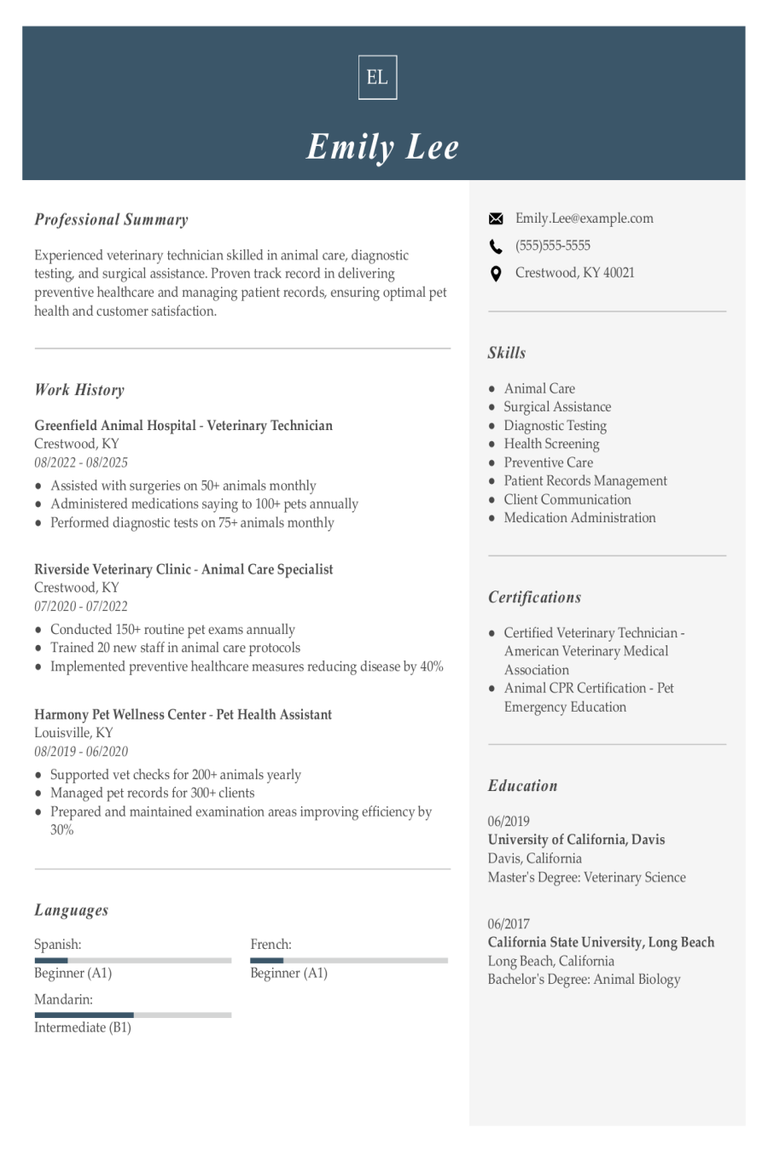
Veterinary Technician Resume Examples & Templates for 2025
Explore veterinary technician resume examples and tips to learn how to showcase your experience caring for animals, assisting vets, and handling lab tests. These samples and tips will help you
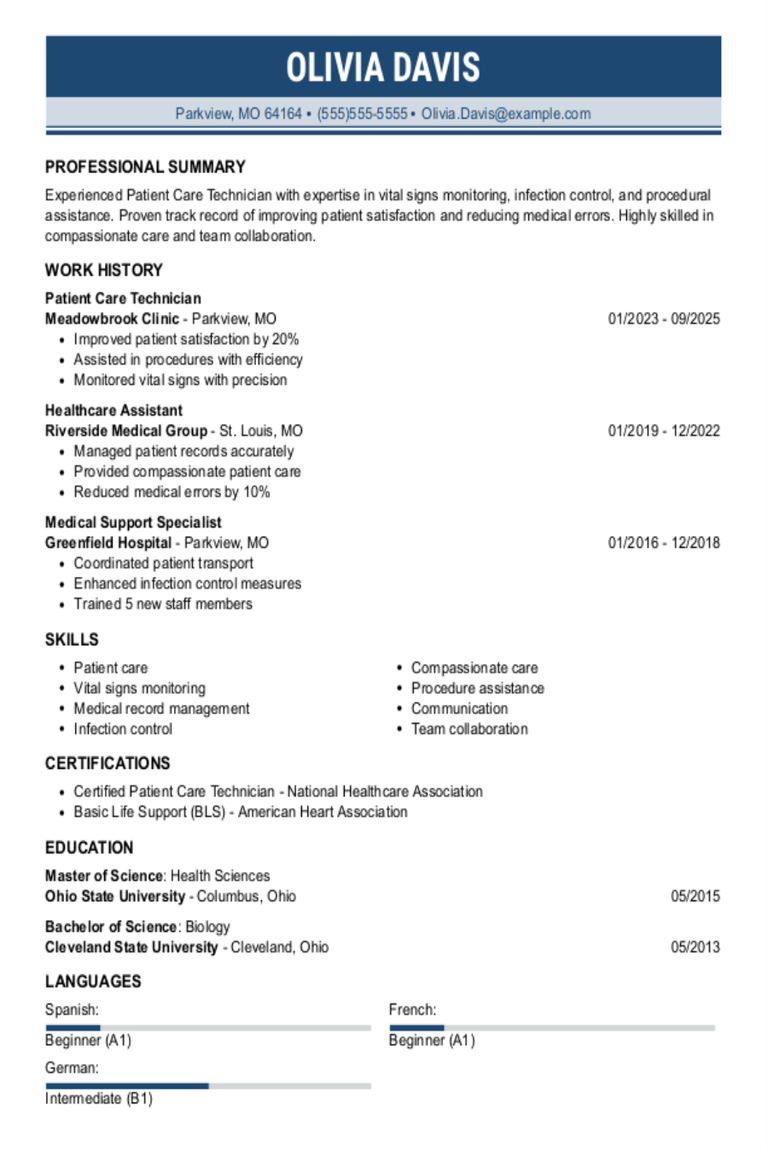
Patient Care Technician Resume Examples & Templates for 2025
Explore patient care technician resume examples to see how to highlight your skills in assisting patients, monitoring vital signs, and supporting medical staff. Discover tips for showcasing your experience in
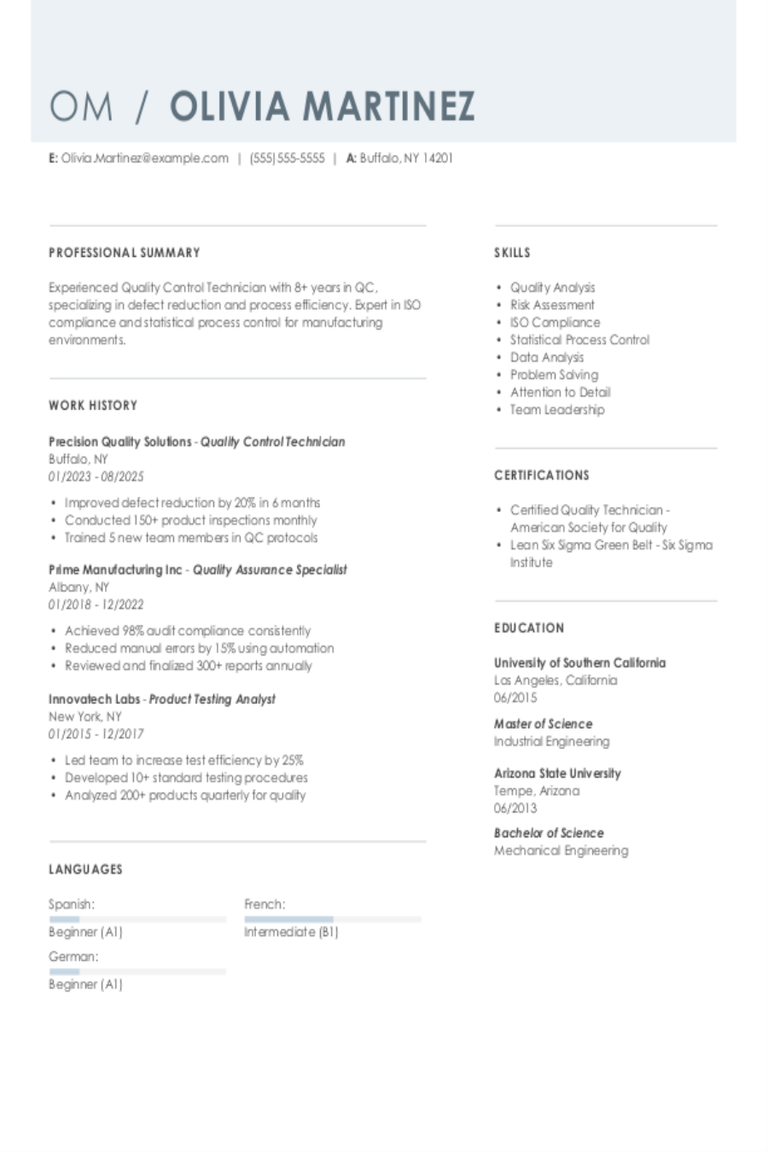
Quality Control Technician Resume Examples & Templates for 2025
Browse quality control technician resume examples to see how to list your skills in testing and inspection. Discover tips on sharing experiences that demonstrate attention to detail and problem-solving abilities
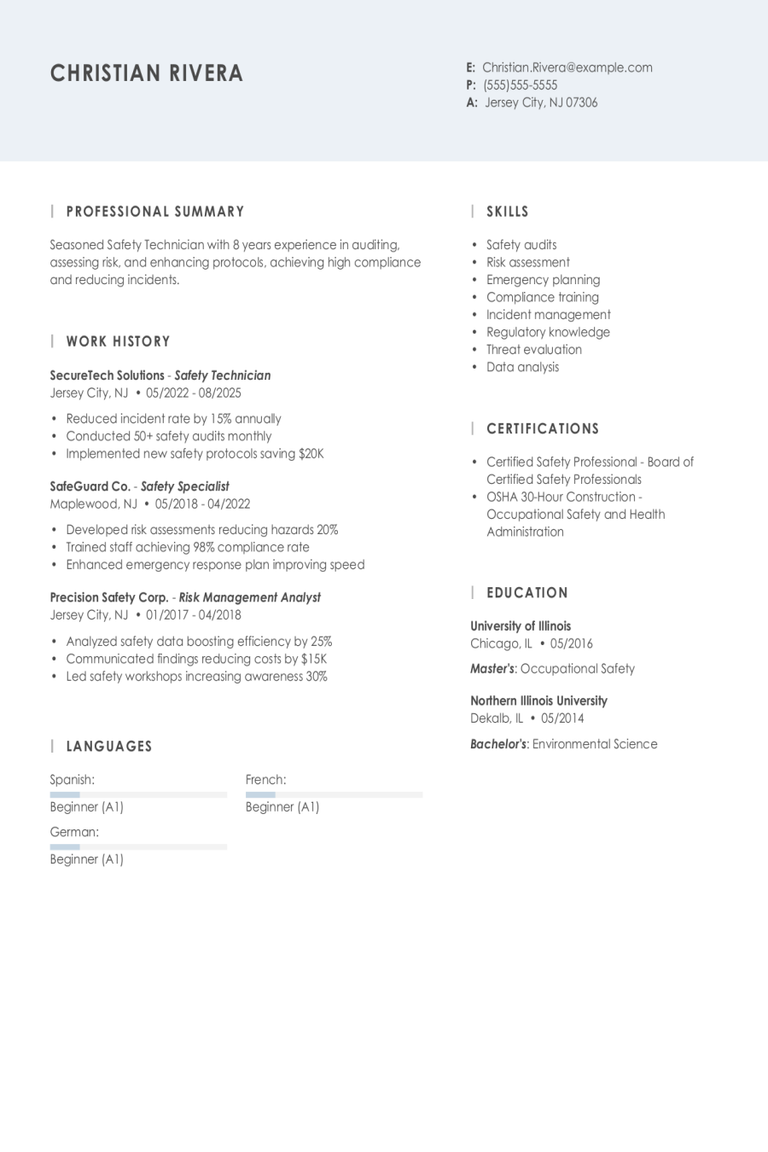
Safety Technician Resume Examples & Templates for 2025
Explore safety technician resume examples that focus on skills like problem-solving, equipment checks, and teamwork. These examples and tips will help you show employers you’re ready to keep workplaces safe
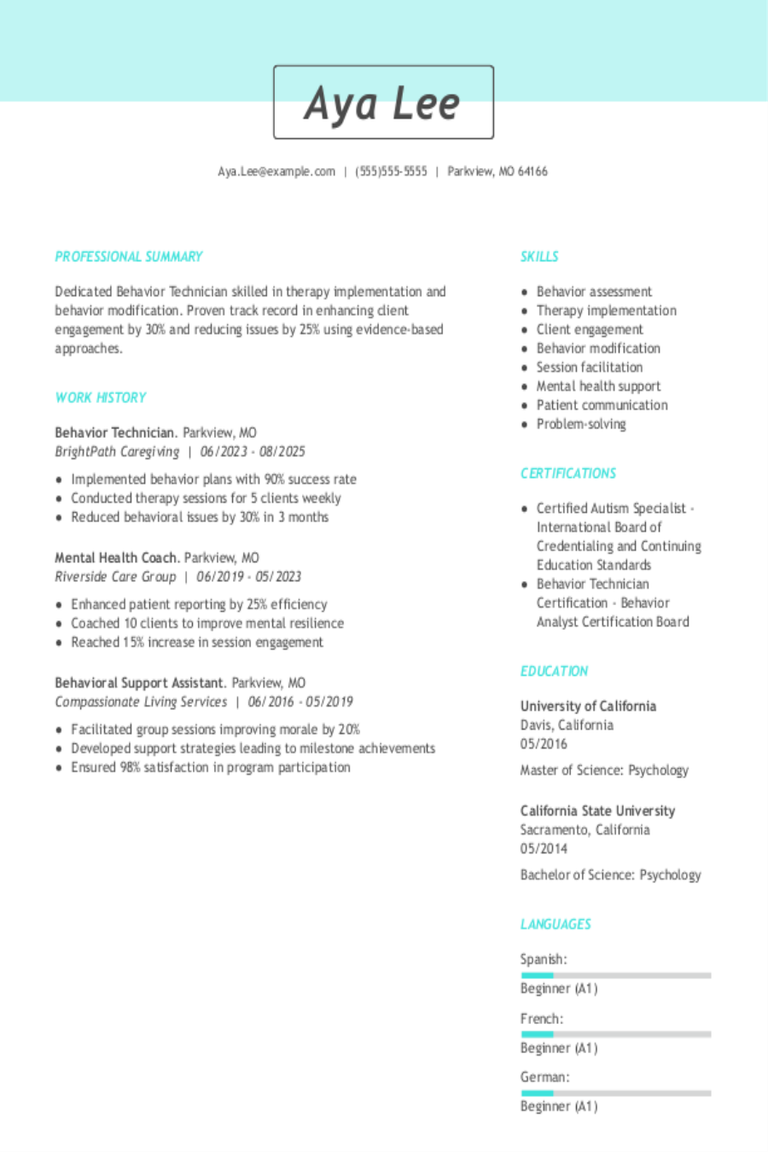
Behavior Technician Resume Examples & Templates for 2025
Discover behavior technician resume examples and learn how to showcase your hands-on experience and make a great impression on potential employers.Build my resumeImport existing resumeCustomize this templateWhy this resume worksQuantifies
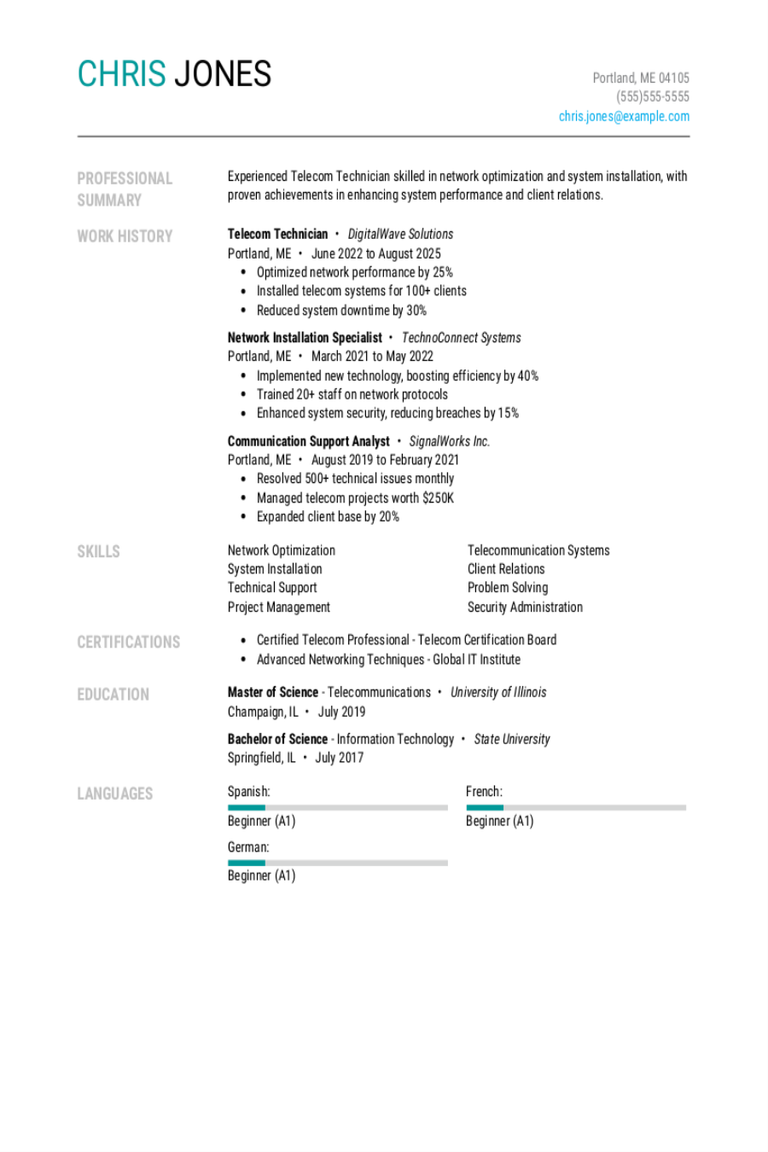
Telecom Technician Resume Examples & Templates for 2025
Browse telecom technician resumes to see how to showcase your experience in fixing and maintaining communication networks, setting up equipment, and solving technical problems. These examples and tips will help
